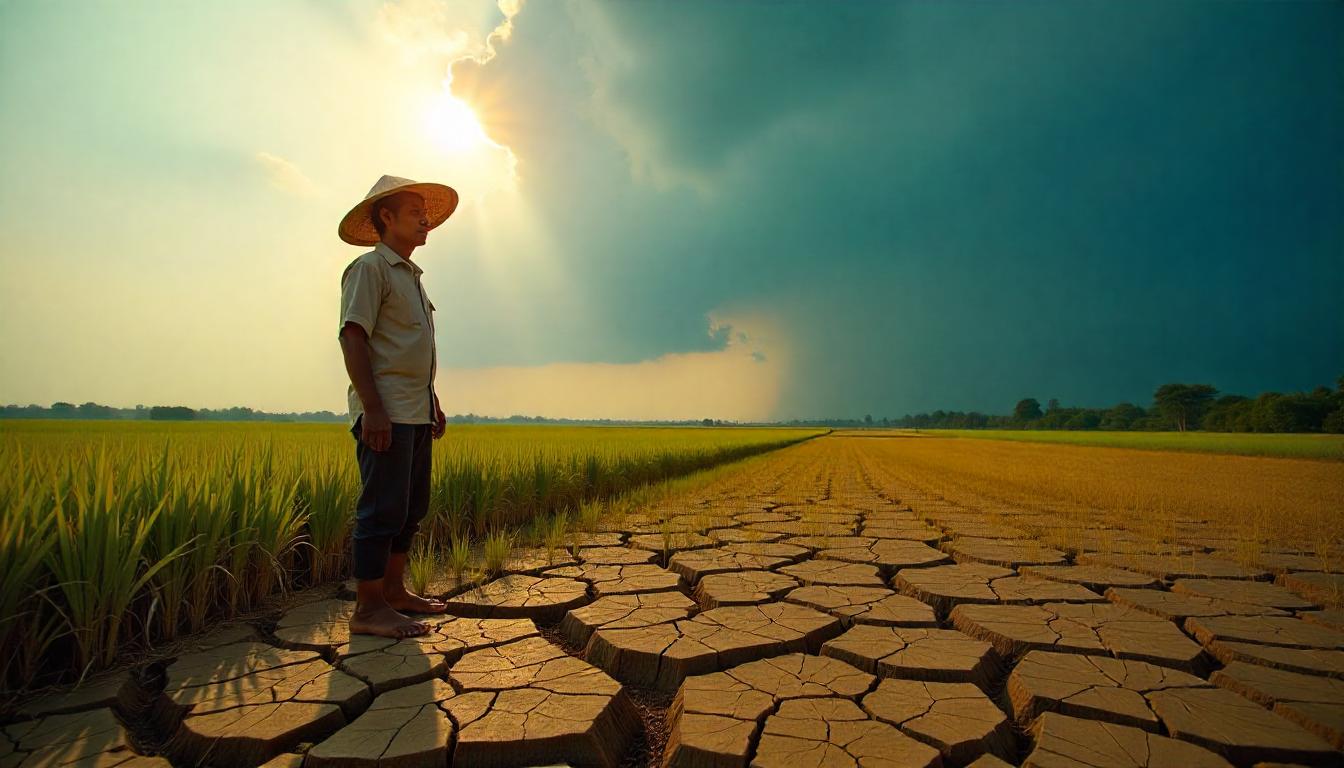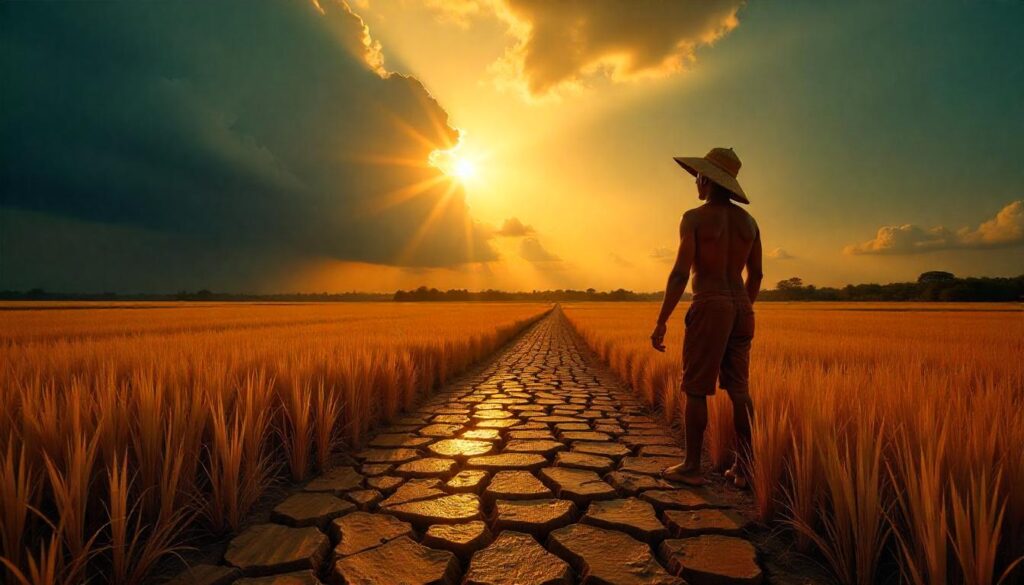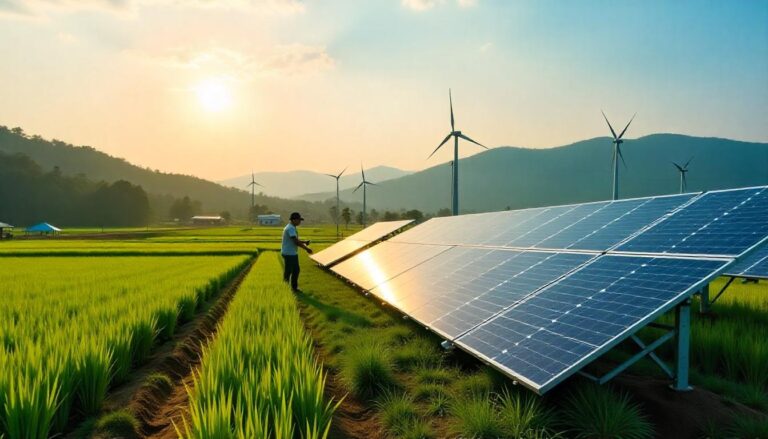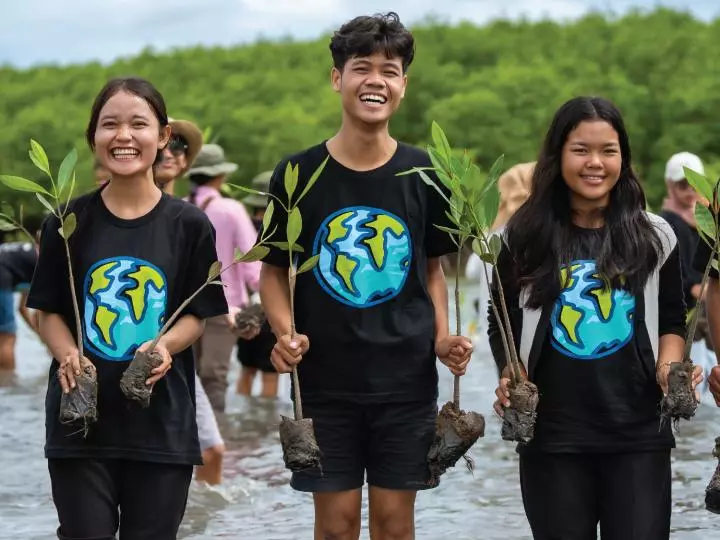Climate’s Grip: Unpacking the Impact of Climate Change on Cambodian Agriculture

Cambodia, a nation deeply rooted in its agricultural heritage, pulses with the rhythm of rice paddies, the bounty of its vast freshwater fisheries, and the quiet resilience of its farming communities. Agriculture is not merely an economic sector; it is the very heartbeat of the kingdom, sustaining livelihoods, nourishing families, and forming the bedrock of national food security. Yet, this vital sector finds itself increasingly caught in the escalating vise of climate change, facing unprecedented threats that challenge its very foundation.
As a nation highly vulnerable to the global climate crisis—ranking as the 4th most exposed to flood risk and 23rd to heat-related impacts globally, according to the recent Cambodia Climate Change Strategic Plan (CCCSP 2024-2033)—Cambodia stands at a critical juncture. The traditional seasons are shifting, extreme weather events are intensifying, and the delicate balance of its ecosystems is under severe strain.
This article delves deep into the impact of climate change on agriculture in Cambodia. We will explore the specific ways in which a warming planet and erratic weather patterns are affecting key agricultural sectors, examine the profound socio-economic repercussions for the nation’s farmers and rural communities, and highlight the crucial adaptation efforts underway to cultivate resilience and secure a sustainable future for food security in Cambodia amidst these growing challenges.
- The Shifting Seasons: Direct Climatic Impacts on Cambodian Farming
- Sector-Specific Vulnerabilities: Rice, Fisheries, and Livestock
- Human Cost: Socio-Economic Impacts on Farmers and Communities
- Cultivating Resilience: Adaptation Strategies and National Efforts
- The Road Ahead: Challenges and Opportunities for a Resilient Future
- Conclusion: Cultivating Hope in the Face of Climate Change
- FAQs (Frequently Asked Questions)
- 1. How is climate change specifically affecting rice production in Cambodia?
- 2. What are the main extreme weather events impacting Cambodian agriculture?
- 3. What is climate-smart agriculture, and how is it being implemented in Cambodia?
- 4. How does climate change impact fishing communities around Tonlé Sap Lake?
- 5. What is the Cambodian government doing to help farmers adapt to climate change?
- 6. Are farmers in Cambodia migrating due to climate change impacts?
The Shifting Seasons: Direct Climatic Impacts on Cambodian Farming
Cambodian agriculture, predominantly reliant on rainfed systems, is acutely sensitive to changes in temperature and rainfall patterns. The direct climatic impacts are becoming increasingly apparent and devastating:
- Rising Temperatures and Heat Stress:Global warming is manifesting in Cambodia as a significant increase in average temperatures, with projections indicating a rise of up to 3.1°C by the 2090s (World Bank). This translates into more frequent and intense heat waves, where temperatures can soar to 40-42°C in April-May. Such extreme heat puts immense pressure on crops, leading to reduced yields as plants struggle to grow and mature. For instance, rice, the country’s staple, is particularly susceptible to heat stress during critical growth stages. Livestock also suffer from decreased productivity and increased susceptibility to diseases, while farmers themselves face significant health risks and reduced work capacity when toiling outdoors in scorching conditions.
- Erratic Rainfall Patterns & Extreme Events:The traditional monsoon patterns, which Cambodian farmers have relied upon for generations, are becoming increasingly unpredictable, leading to a perilous duality of too much or too little water:
- Droughts: These prolonged periods of water scarcity are occurring with greater frequency and severity. Over 30% of Cambodia’s cropland in exposed provinces (like Prey Veng, Svay Rieng, and Pailin) experiences drought stress every five to six years. Droughts can be even more destructive than floods for rice production, drying up irrigation sources and forcing farmers to abandon harvests. In the 2024 dry season, for example, 30,000 hectares of rice were identified as being at risk of drought, with authorities actively pumping water to mitigate damage. Earlier, in the 2024 dry season, approximately 120,000 hectares across 17 provinces were affected by drought, with 25% of those fields damaged, despite significant government intervention saving the rest.
- Floods: Conversely, Cambodia is globally recognized as the fourth most flood-exposed country. Heavy, sporadic rainfall during the monsoon season, coupled with the overflow of the Mekong River and Tonle Sap Basins, causes extensive riverine and flash flooding. The 2024 floods significantly impacted over 59,000 households and damaged approximately 29,300 hectares of rice and 3,100 hectares of other crops. Past events have been equally catastrophic, with the 2013 floods alone causing an estimated $356.3 million in losses. The human toll is also severe, with floods accounting for almost 90% of disaster displacement recorded in 2023.
- Combined Hazards: A particularly devastating scenario involves the occurrence of extreme drought and flood events within the same rice cultivation cycle, leaving farmers with virtually no chance of a successful harvest or recovery.
- Water Scarcity and Saline Intrusion:Beyond direct rainfall changes, increased evaporation rates contribute to widespread water scarcity, limiting access to crucial irrigation, especially for dry-season crops. In Cambodia’s coastal areas, the threat of sea-level rise intensifies, leading to saltwater intrusion into freshwater sources and agricultural lands, rendering them infertile and displacing farming communities.
These direct climatic shifts are creating an increasingly volatile and precarious environment for Cambodian agriculture, challenging traditional farming practices and demanding urgent adaptation.
Sector-Specific Vulnerabilities: Rice, Fisheries, and Livestock
The impacts of climate change are not uniform; they disproportionately affect Cambodia’s core agricultural pillars, each with its unique vulnerabilities.
- Rice: The Lifeblood Under Threat:”Rice is life” in Cambodia, underpinning national food security and supporting millions of livelihoods. However, this predominantly rainfed crop is on the front lines of climate change. Projections indicate a significant decline in rice yields by 10-15% in the 2040s (Energy Tracker Asia, GIZ). Recent figures from early 2024 already show Cambodia’s rice exports down by 7.2%, partly reflecting climate-induced challenges. Farmers consistently report disrupted planting seasons and reduced production in both wet and dry seasons due to the erratic timing and intensity of rainfall. The unpredictable weather makes it incredibly difficult for many to achieve even a single successful harvest, let alone multiple.
- Fisheries: The Mekong’s Diminishing HarvestThe rich freshwater fisheries of the Mekong River and the Tonle Sap Lake are vital sources of protein and income for millions of Cambodians. These ecosystems are exquisitely sensitive to changes in water levels and flow, which are being severely impacted by climate change and, crucially, upstream hydropower dam construction. Fishermen along the Tonle Sap Lake are voicing serious concerns, with some reporting fish catches have dwindled to “ten times less” than a decade ago (Khmer Times, March 2025). While overexploitation (e.g., illegal fishing) is also a factor, irregular water pulses from the Mekong, influenced by climate and dams, reduce the crucial seasonal inflows that fish rely on for breeding and feeding. The resulting declining fish populations threaten the very fabric of communities reliant on this vital resource.
- Livestock Farming:Cambodia’s livestock sector also faces direct challenges from climate change. Increased ambient temperatures and prolonged heatwaves cause heat stress in animals, leading to reduced appetite, slower growth rates, decreased milk or egg production, and increased susceptibility to diseases. Changes in rainfall patterns affect the availability and quality of pasture and fodder, further impacting animal health and farmer income.
These direct and sectoral impacts underscore the urgent need for comprehensive strategies to protect Cambodia’s agricultural base and the millions of people who depend on it.
Human Cost: Socio-Economic Impacts on Farmers and Communities
The technical effects of climate change on agriculture translate directly into profound human costs, particularly for the rural poor, who are least equipped to cope.
- Food Insecurity & Livelihood Erosion:Erratic weather patterns, leading to successive crop failures, directly threaten food security in Cambodia. For smallholding farmers, who comprise the majority of the agricultural workforce, repeated losses of harvests mean not only a lack of food but also the loss of their primary income source and investment (seeds, fertilizers). Climate change could potentially reduce Cambodia’s GDP by 10% by 2050, with a disproportionate impact on rural areas, exacerbating poverty and widening existing inequalities. Farmers often find themselves trapped in a cycle of debt, unable to recover from one climate shock before the next one hits.
- Climate Migration and Displacement:When traditional farming becomes unviable, people are forced to seek alternatives. Climate change is a significant driver of internal migration in Cambodia. Since 2008, over 900,000 internal displacements have been linked to disasters, with floods alone accounting for almost 90% of disaster displacement in 2023. Farmers, facing chronic crop losses and dwindling income, are increasingly resorting to temporary migration for work (rural-urban or even cross-border) as a coping mechanism. The 2023 Census of Agriculture Cambodia revealed a 13% decline (280,000 households) in agricultural households compared to 2013, indicating a significant shift away from traditional subsistence farming, driven partly by mounting climate pressures.
- Health Implications:The human toll extends to public health. During severe floods, the risk of waterborne diseases like cholera significantly increases. Furthermore, rising temperatures contribute to the spread of vector-borne diseases such as malaria and dengue fever. Outdoor agricultural laborers are particularly vulnerable to heat stress, leading to dehydration, heatstroke, and reduced productivity.
These intertwined socio-economic impacts underscore the urgent need for holistic solutions that address not only agricultural productivity but also human well-being and adaptive capacity.
Cultivating Resilience: Adaptation Strategies and National Efforts
Recognizing the existential threat, the Cambodian government, in collaboration with international partners, has launched significant initiatives to build climate change adaptation in agriculture in Cambodia and foster resilience.
- National Policy Frameworks:Cambodia has developed a robust policy landscape to guide its climate action:
- Cambodia Climate Change Strategic Plan (CCCSP): The recently launched CCCSP 2024-2033 is a pivotal national policy, building upon its predecessor. It sets out ambitious goals for strengthening climate adaptation, reducing greenhouse gas emissions across sectors (including agriculture and land use), and promoting good governance.
- National Adaptation Plan (NAP) Process: Initiated in 2014, the NAP aims to systematically integrate climate change adaptation into national and sectoral planning, with agriculture, forestry, and fisheries identified as priority sectors for vulnerability reduction.
- Nationally Determined Contribution (NDC): Cambodia submitted an updated NDC in December 2020, outlining 17 prioritized adaptation actions for agriculture. These focus on enhancing agricultural value chains, improving water management, fostering climate-resilient crop development, and providing crucial support services to farmers.
- Long-Term Strategy for Carbon Neutrality (LTS4CN) by 2050: This strategy further reinforces Cambodia’s commitment to climate action, including efforts to reduce emissions where possible within the agricultural sector.
- Key Adaptation Measures in Agriculture:Practical on-the-ground interventions are crucial for building resilience:
- Climate-Smart Agriculture (CSA): This approach integrates climate change considerations into agricultural practices. Examples include
- Drought-resistant and flood-tolerant crop varieties: Introducing new rice varieties that can withstand extreme conditions.
- Diversified cropping systems: Promoting mixed farming, intercropping, and agroforestry to reduce reliance on single crops.
- Improved irrigation techniques: Implementing more efficient water use, such as “Alternate Wetting and Drying” (AWD) for rice, to conserve water.
- Sustainable soil management: Practices like conservation tillage and the use of biochar to improve soil health and water retention.
- Capacity building and training: Empowering farmers with knowledge and skills on these new practices. The government’s program to deploy agricultural specialists to all farming communes since 2024 aims to enhance techniques at the grassroots level.
- Water Resource Management: Investments are being made in resilient irrigation infrastructure, rainwater harvesting technologies, and more efficient water distribution systems to cope with erratic rainfall.
- Early Warning Systems: Enhancing systems that provide timely meteorological information and disaster alerts, enabling farmers to make informed decisions about planting, harvesting, and protecting assets.
- Livelihood Diversification: Supporting farmers in developing alternative income streams (e.g., aquaculture, small businesses, non-farm employment) to reduce their sole reliance on climate-vulnerable agriculture.
- Climate-Smart Agriculture (CSA): This approach integrates climate change considerations into agricultural practices. Examples include
- Role of International and Local Partners:International support is critical for scaling up these efforts. The Green Climate Fund (GCF), for instance, has initiated comprehensive projects in Cambodia to enhance agricultural resilience by focusing on resilient agricultural value chains, efficient water management systems, and climate-resilient crop varieties. Organizations like the Mekong River Commission (MRC) also support improved irrigation, fish reproduction facilities, and transboundary water management. Numerous NGOs and development partners work at the grassroots level, providing technical assistance, facilitating access to climate finance for smallholders, and advocating for farmer-centric policies.
The Road Ahead: Challenges and Opportunities for a Resilient Future
While significant strides are being made, the path to a fully climate-resilient agricultural sector in Cambodia faces persistent challenges:
- Financial Gaps: Scaling up adaptation measures across millions of smallholder farms requires substantial and sustained financial investment, far exceeding current allocations.
- Knowledge & Technology Transfer: Ensuring that scientific research and new technologies effectively reach and are adopted by rural farmers, who may have limited access to information or resources, remains a critical hurdle.
- Institutional Coordination: Effective climate action requires seamless coordination across various government ministries, local authorities, and development partners.
- Data & Monitoring: Continuous improvement in climate data collection, impact monitoring, and early warning systems is essential for adaptive management.
- Addressing Root Causes: Beyond climate, issues like illegal fishing (contributing to Tonle Sap’s decline) and deforestation (impacting water cycles and soil stability) must also be robustly addressed.
Despite these challenges, opportunities for transformation abound:
- Increased Investment: Growing global and national recognition of climate change provides avenues for increased climate finance and green investment.
- Innovation: Adoption of new agricultural technologies, digital tools for climate information, and innovative financing mechanisms can accelerate resilience building.
- Youth Engagement: Empowering and engaging younger generations in climate-smart agriculture can bring new energy and ideas to the sector.
- Public-Private Partnerships: Collaborative efforts between the government, private sector, and local communities can drive more comprehensive and sustainable solutions.
- Policy Implementation: Strong government commitment and the recent launch of the CCCSP 2024-2033 provide a robust framework for action.

Conclusion: Cultivating Hope in the Face of Climate Change
The impact of climate change on agriculture in Cambodia is profound, far-reaching, and undeniably urgent. From the existential threats of erratic floods and droughts to the socio-economic vulnerabilities faced by millions of farmers, the climate crisis is reshaping the very landscape of Cambodian life. The decline in traditional agricultural households and the pressures on vital resources like rice and fish underscore the severity of the challenge.
Yet, amidst these escalating threats, there is a growing resolve. Cambodia’s strategic national plans, combined with the tireless efforts of farmers, communities, and international partners, are cultivating resilience. By prioritizing climate-smart agriculture, strengthening water management, building early warning systems, and fostering livelihood diversification, Cambodia is striving to safeguard its agricultural heritage and secure a more stable future. The journey ahead is complex, but with continued investment, innovation, and a collective commitment, Cambodia can emerge as a testament to adaptation, cultivating hope even in the face of climate’s grip.
What climate-smart agriculture practice do you believe is most crucial for Cambodian farmers? Share your thoughts, questions, or experiences in the comments below, and help us continue the conversation on building a more resilient agricultural future for Cambodia!
FAQs (Frequently Asked Questions)
1. How is climate change specifically affecting rice production in Cambodia?
Climate change impacts rice production in Cambodia primarily through erratic rainfall patterns leading to more frequent and intense droughts and floods. This disrupts planting and harvesting cycles, reduces yields, and can cause total crop failure. Rising temperatures also cause heat stress on rice plants, further lowering productivity.
2. What are the main extreme weather events impacting Cambodian agriculture?
The main extreme weather events impacting Cambodian agriculture are severe droughts (prolonged periods of water scarcity) and intense floods (both riverine and flash floods). Heatwaves with temperatures exceeding 40°C are also increasingly prevalent, causing significant stress on crops and livestock.
3. What is climate-smart agriculture, and how is it being implemented in Cambodia?
Climate-Smart Agriculture (CSA) is an approach that helps agricultural systems adapt to climate change, mitigate greenhouse gas emissions, and sustainably increase productivity. In Cambodia, it’s being implemented through practices like introducing drought-resistant and flood-tolerant rice varieties, promoting diversified cropping systems, improving irrigation efficiency (e.g., Alternate Wetting and Drying), and providing farmer training on these new techniques.
4. How does climate change impact fishing communities around Tonlé Sap Lake?
Climate change, alongside upstream dam construction, significantly impacts fishing communities around Tonlé Sap Lake by disrupting the natural flood pulse of the Mekong River. This leads to lower and more irregular water levels, which reduces fish breeding grounds and food sources, resulting in declining fish populations and, consequently, reduced catches for local fishermen.
5. What is the Cambodian government doing to help farmers adapt to climate change?
The Cambodian government is taking significant steps, including launching the Cambodia Climate Change Strategic Plan 2024-2033 (CCCSP 2024-2033), which outlines adaptation goals for agriculture. They are also implementing the National Adaptation Plan (NAP) process, promoting climate-smart agriculture practices, deploying agricultural specialists to communes, and seeking international climate finance to support adaptation initiatives like improved irrigation and resilient crop varieties.
6. Are farmers in Cambodia migrating due to climate change impacts?
Yes, there is increasing evidence of climate migration in Cambodia. As climate change impacts, such as prolonged droughts and severe floods, lead to repeated crop failures and income loss, many farmers are forced to seek alternative livelihoods or engage in temporary rural-urban migration or even international migration as a coping strategy. The 2023 Census of Agriculture showed a notable decline in agricultural households, reflecting this shift.



